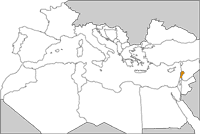 |
Protected Sites
Sites of Biological/Ecological Significance
- El Kalb river
- Beirut river
- El Assi river
- Arakah river
- Awali river
- Ibrahim river
- El Jaouz river
- Damour valley
- Qadisha valley
- Karakeer valley
- Sanine Mountain
- Makmel Mountain
- Chouf Area
- Tabarja coast
- Qamouha
- Balouaa Balaa sinkhole
Sites of Touristic Significance
- Cedars of Bcharee
- Deir El Qalaa
- Boulogne Forest
- El Mrouj Oak
- Beirut Horsh
- El Laban spring
- Baalback
Protected Forests
- Chouf Cedars
- Batroun area
- Kherbet silm
- Zaidani
- Kfar zabad
- Tannourine, Hadeth El Jebbeh, Arz elRab
- Swayse
- Bazbina
- Qaryet el sfina
- Merbine
- El Houkaylat spring
- Chebaa
- Jurd el Njas
- Bkassine forest
Nature Reserves
- Al Shouf Cedars Nature Reserve (www)
- Horsh Ehden Nature Reserve (www)
- Tannourine Cedars Forest Nature Reserve (www)
- Bentael Nature Reserve
- Tyre Coast Nature Reserve
- Palm Island Nature Reserve
- Yammouneh Nature Reserve
- Karm Chbat Nature Reserve
Ramsar Sites
- Palm Island Nature Reserve
- Tyre Coast Nature Reserve
- Ammiq Wetland
- Ras El Chaqua
Important Bird Areas
- Al Shouf Cedars Nature Reserve (www)
- Horsh Ehden Nature reserve (www)
- Palm Islands Nature Reserve
- Ammiq Wetland
World Heritage Sites
- Baalback
- Anjar
- Tyre
- Byblos
- Wadi Qadisha
Specially Protected Areas
- Palm Island Nature Reserve
Nature Biosphere Reserves
- Al Shouf Cedars Nature Reserve (www)
|
Protected Areas in Lebanon
The Ministry of Environment in Lebanon was established in 1993.
In Lebanon, we have been designating Protected areas since 1930, hence, another body used to establish, designate and administer PA.
Yet, till today, we have no apriori set criteria which governs the establishment of PA thus we still lack a proper system of PA categorization.
Nevertheless, the EU-funded project SISPAM which is expected to finish in early next year is responsible for defining a system for categorizing PAs as well as for defining the criterion for every category.
As for the existing protected areas divisions, PAs are either divided by who has established them or by the legal document that have established them. Yet, particularly interesting and uniquely gaining much interest for administration and management are the nature reserves that fall under the authority of MOE.
An easy way to embrace all PAs is:
A) Protected Sites
- Sites of biological/ ecological significance: sites that are protected by MOE for their biological and/ or ecological significance including valleys, mountain summits, river beds and others.
- Sites of touristic significance: sites that are protected by Ministry of Tourism because of their touristic value including landscapes, natural monuments and others.
- Protected Forests: sites protected by Ministry of Agriculture by the Forest Code.
B) Nature reserves
C) Ramsar Sites
D) Important Bird Areas
E) World Heritage Sites
F) Specially Protected Areas
G) Nature Biosphere Reserves.
The Lebanese protected areas website is still under construction.
Sources: Ministry of Environment (MOE) - Lebanon
|
|


